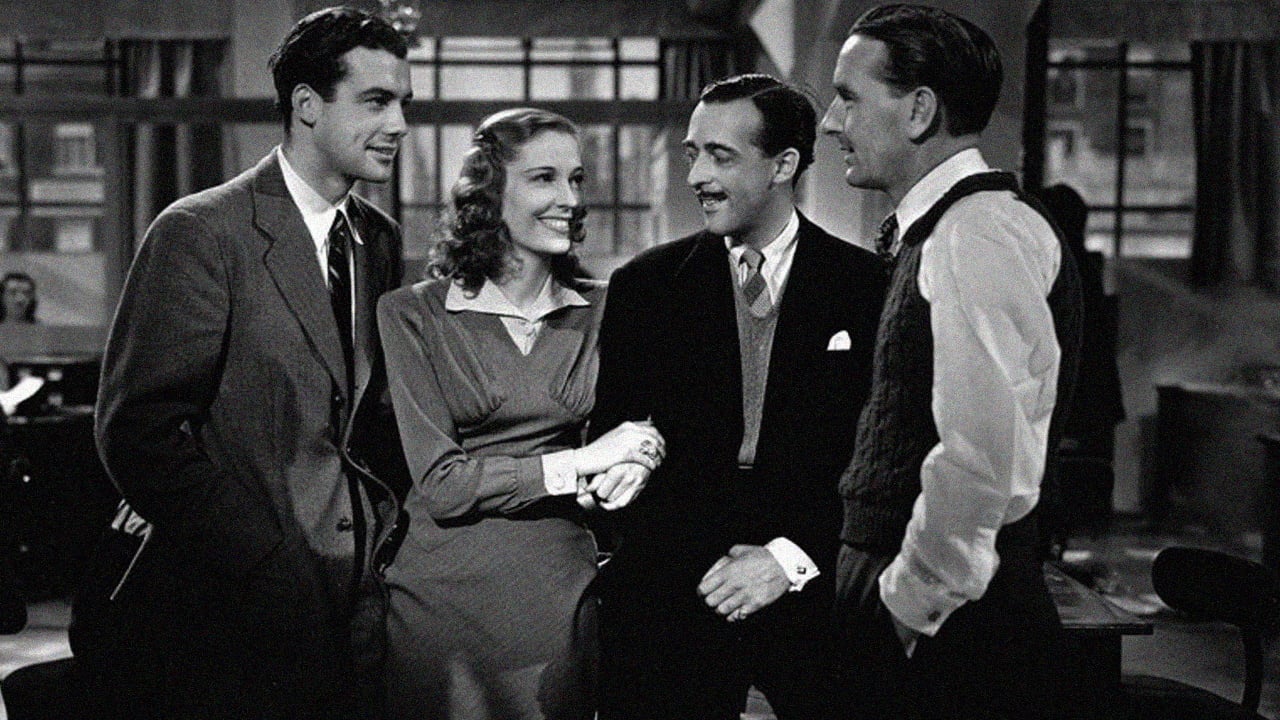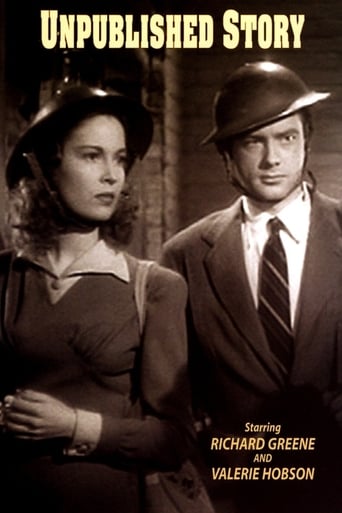

A Two Cities Film, made at D & P Studios, Denham, presented by J. Arthur Rank, released through Columbia Pictures Corp. Not copyrighted in the U.S.A. No New York opening. U.S. release: 11 April 1942. U.K. release: 10 August 1942. Australian release: 23 September 1943 (sic). 8,444 feet. 93½ minutes.SYNOPSIS: British newspaperman tangles with Nazi spies in London during the blitz.COMMENT: Despite some very conventional characters and plot strands in this wartime newspaper yarn, this is a truly remarkable film. Aside from the actuality footage of the London blitz which is skilfully worked into the fabric of the movie itself - horrifying, unbelievable material of human ingenuity, courage, perseverance and insistence on "normalcy" in the face of incredibly wanton destruction, peril and danger - there are a number of astonishing set-pieces including an extended dolly shot of vast crowds of evacuated Dunkirk servicemen at a railway station and a skilfully disorienting tracking shot down a London street in a black-out. The lighting, compositions and camera movement often reveal an imaginative skill far beyond the normal rather humdrum standards of director Harold French. At times indeed the terrifyingly real-life bizarreness of the movie's background overshadows the story - particularly Valerie Hobson's part in it which has been struck from the cliched mould of novice girl reporter makes good (though she does figure in an edge-of-the-seat cliffhanger bit of action which would put any Hollywood serial to shame). Greene is also solidly conventional though he does have opportunities to show his mettle. The other players are likewise predictably cast and serve their roles with the fine exactitudes we might expect, though we should note Ronald Shiner in a small but straight role, and the wonderfully realistic portrait of Frederick Cooper as the belittled Trapes. Production values are amazingly lavish. Although there's plenty of vividly staged action, it is even more for its contemporary insight into London living in the truly horrifying nights of 1941-42, that merits Unpublished Story a top place in British cinema.
... View MoreThe British wartime authorities' perennial obsession with fifth columnists ('enemy agents' were serving as baddies as early as the 1940 George Formby vehicle 'Let George Do It!') here finds elaborate expression in an ambitious production set in London during the Blitz. It took five credited writers to concoct this frequently hard to follow propaganda piece in which actual footage from the Blitz is adroitly combined with recreated studio footage. Censorship is benignly depicted as an essential part of the war effort (hence the title), while a pacifist organisation called 'People for Peace' is revealed to be not simply a Nazi front organisation run by British reactionaries but headed by authentic German 'sleepers' who privately converse among themselves in German. (With acts of terrorism in Europe by refugees from the Middle East now becoming almost everyday occurrences, the sequence depicting the arrival of a German agent masquerading as a Belgian refugee has disturbing contemporary resonances.)Richard Greene and Valerie Hobson are colourless leads, and dependable supporting actors like Basil Radford, Roland Culver and André Morell are generally given remarkably little to do; with the notable exception of Brefni O'Rorke as the editor of 'The Gazette', the newspaper the plot revolves around, who gets to deliver the film's stirring final speech at the fadeout.
... View MoreReporter Richard Greene (Randall) returns from Dunkirk and heads straight to his newspaper HQ to tell the story. He is motivated to get the truth to the public and cannot abide peace sympathisers such as the "People for Peace" movement who he wants to expose. However, this group seems to have an ulterior motive. Valerie Hobson (Carol) is a rookie reporter who joins him in his adventures.Well, it's all rather boring. The accents are quite difficult to understand – you have to adjust yourself to the rapid plumy diction. What on earth are they saying? The Scottish bloke speaks the most clearly! Once you get over this you wait for a plot but after about 50 minutes there still isn't anything going on. It's a film about reporters during WW2 but no strong lead story. What is this film about? Worse, we have to follow proceedings as led by the thoroughly dislikable Richard Greene. The rest of the cast also fall flat apart from Valerie Hobson. You spend a lot of this film waiting for something to happen and daydreaming about better things.
... View MoreThis is a superior early wartime 'message picture' containing a great deal of real footage of the London Blitz, not all of which I recognised. Richard Greene and Valerie Hobson play two journalists working for the newspaper, the London Gazette, and much of the film takes place in the newsroom. The film's plot largely concerns a British 'peace society' which has been heavily infiltrated by Nazi agents. Anyone who doubts that that is how things worked with the Nazis has only to read the two books INSIDE THE GESTAPO and INSIDE INFORMATION by the high-ranking Gestapo defector (who reported directly to Heydrich) Hansjuergen Koehler to get the true picture. That is precisely how the Gestapo used the 'peace societies', as fronts for espionage and subversion. The Soviet Union did the same thing. It is such a standard and obvious technique that it is a wonder that anyone is left who does not see it clearly, but there are always fools aplenty. This film's message is thus very direct, but also very correct. It is warning the British public not only about appeasers, which abounded in Britain (Neville Chamberlain being the most prominent!), but about the woolly-headed idealists pursuing 'peace', which simply cannot be done with people like the Nazis. (See Dame Flora Robson's amazing performance in GUNS AT BATASI, 1964, for perhaps the best portrayal of a 'peace junkie' out of her depth.) There are numerous old faithfuls in the supporting cast, Basil Radford as a good buy, Roland Culver as a bad guy, Andre Morrell as a Gestapo agent, Frederick Cooper as a 'peace junkie' who discovers he has been manipulated by the Nazis and who then is to be seen pouring more sweat from terror than if he had been under twenty arc lights, and plenty of other excellent character actors. The film is well directed by Harold French, one of the directors of the three excellent Somerset Maugham anthologies (QUARTET, TRIO, and ENCORE), and who lived to be 100 years old (1897-1997)! Strange to think the last feature film he directed was in 1955 (THE MAN WHO LOVED REDHEADS with Moira Shearer) and that he then lived another 42 years. I wonder what he was doing. The film is based on a story by its producer, Anthony Havelock-Allan, famous for producing David Lean's BRIEF ENCOUNTER (for which he was uncredited), Lean's GREAT EXPECTATIONS, Lean's RYAN'S DAUGHTER, Franco Zeffirelli's ROMEO AND JULIET, and many more. He died in 2003, just before turning 99. So between them, the producer and the director of this film lived for just under 200 years. What were they taking? Maybe if we all watch this film 100 times we will all live forever.
... View More